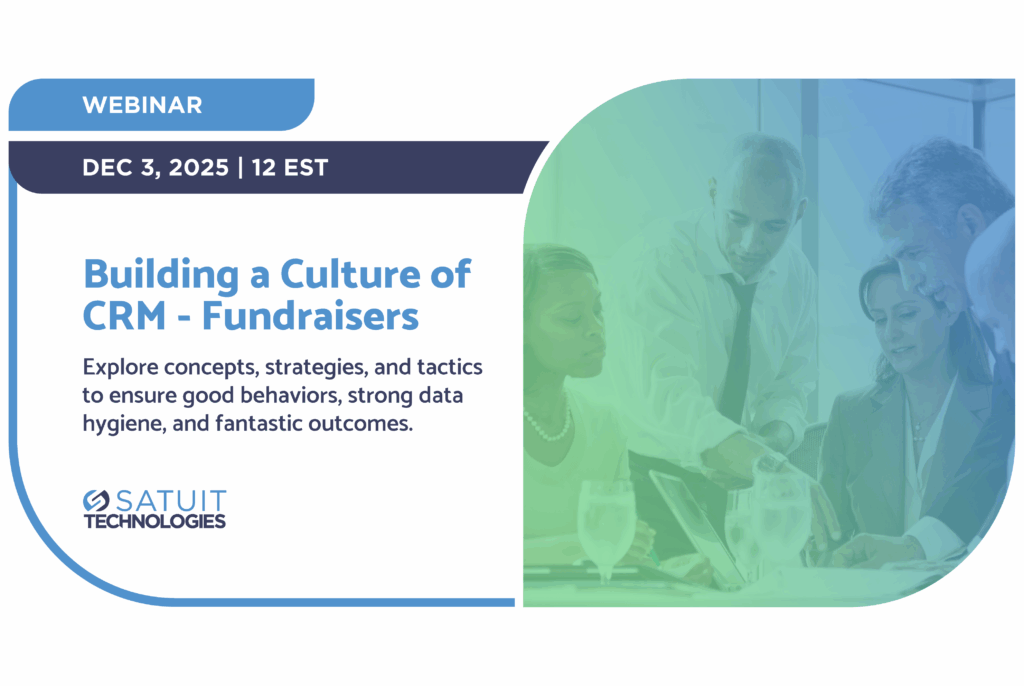Is your client relationship management (CRM) system helping your investment firm grow, or is it just another expensive tool your team reluctantly uses? For investment professionals, wealth managers, and financial advisors, a CRM is a lever that can deepen client relationships, optimize business processes, and drive asset growth. Yet, many wealth management firms are left with sophisticated platforms that fail to deliver meaningful results.
However, when a CRM isn’t working, the problem usually isn’t with the software itself. It’s how your team uses it, how your processes are set up, and whether your data is properly organized. Before investing in new technology, take time to evaluate your current CRM ecosystem. This guide will help you determine if your current challenges can be fixed with better processes or if it’s time to upgrade your software.
Why Should You Audit Your CRM Software?
For investment managers, portfolio managers, and wealth management professionals, an effective CRM is the driving force behind your client relationships and deal flow. When your CRM isn’t set up correctly, you’ll notice the following issues:
- Opportunities get lost between systems
- Making decisions becomes guesswork
- Your best people waste time on paperwork
- You feel unprepared for client calls
A systematic assessment of your CRM will uncover these issues and provide a clear blueprint for improvement. Let’s break down how to check if your CRM is actually helping your investment business grow:
The Seven Areas to Evaluate for CRM Health
1. Strategic Alignment: Does Your CRM Support Your Business Goals?
Your CRM should directly support your firm’s differentiated value proposition and growth objectives. Here are some top considerations for examining your CRM:
- Can your CRM track the specific type of clients you serve?
- Does it help you meet regulatory requirements for client communications?
- Can new team members quickly learn how to use the system?
- Does it integrate with other essential software at your business?
Make a list of your firm’s top 3 business goals for the year. Then, check whether your CRM has specific features that directly help with each goal. If not, you’ve identified a gap.
2. Business Development: How Well Does Your CRM Handle Sales and Deal Sourcing?
Effective client acquisition depends on clear visibility into your pipeline at every stage. When properly configured, a robust system can eliminate friction in business development and multiply your revenue growth. Ask yourself:
- When a new lead comes in, does your CRM automatically assign it to the right person?
- Can you quickly see which deals are closest to closing and their potential value?
- Does your team know exactly where each prospect is in your sales pipeline?
- Can you run a report showing which referral sources bring you the most valuable clients?
Choose five recent deals your firm closed and try tracing them in your CRM from first contact to signed agreement. How many steps were manual? How many times did information have to be re-entered? Count the friction points to get an idea of how your system supports automation.
3. Team Adoption: Is Your Team Actually Using the CRM?
One of your most valuable CRM assessment tools is your team and their insights. Consider gathering feedback across multiple departments to identify your system’s strengths and limitations. Look for patterns in the responses to identify your most pressing CRM challenges. Ask yourself and your team the following:
- Look at how many client meetings happened last month, then check how many were logged in your CRM. Is there a big gap?
- When you ask advisors about a client, do they check the CRM or their personal notes?
- Does your team perceive the CRM as a valuable tool or an administrative burden?
- Can team members update the CRM while visiting clients, or do they have to wait until they’re back at their desk?
- How many team members use the CRM on mobile devices?
Run a report showing which team members logged into your CRM last week and how many actions they recorded. If some people are barely using the system while others use it heavily, you have an adoption problem to solve.
4. Data Quality: How Good Is Your Client Data?
Data quality serves as the foundation for everything your wealth management practice delivers. Without accurate and integrated client information, even the most advanced systems will underperform. Examine your data integrity by asking:
- Calculate your data percentage score. For example, what percentage of required fields are filled in across client records?
- When a client updates their information in your portal, does it automatically update in your CRM?
- If you ask three different team members about a client’s investment goals, will they give the same answer?
- When advisors prepare for client meetings, do they need to look in multiple systems to get a complete picture?
- Can you identify your most valuable client relationships using CRM data alone?
Choose a client who’s been with your firm for over a year to test the reliability of your CRM data. You should look for complete communication history, investment preferences, and family information. How many places did you need to look? How long did it take?
5. Workflow Efficiency: Does Your CRM Save Time or Waste It?
Time is money in wealth management. Advisors should spend their hours building relationships and analyzing portfolios, not struggling with technology. Consider the following to evaluate whether your system accelerates or hinders workflows:
- How many clicks or minutes does it take to onboard a new client from the first meeting to fully set up?
- Do users need multiple workarounds to accomplish routine tasks like quarterly reviews? Do these tasks require manual setup, or does the system remind you automatically?
- Can team members easily see their daily task list and what needs attention first?
- When compliance requirements change, do you have to update processes in multiple places?
Check the efficiency of your CRM by timing how long it takes to complete the following tasks: creating a new prospect, scheduling a client review meeting, generating a client birthday reminder, and recording meeting notes. If any take more than two minutes, your process needs streamlining.
6. Client Experience: How Well Does Your CRM Support Client Relationships?
The hallmark of exceptional wealth management is seamless, personalized service delivered across every interaction. Modern systems should enhance these relationships by enabling comprehensive visibility and proactive communication. Determine if your platform strengthens client connections by asking:
- Can you easily see when a client was last contacted and what was discussed?
- Does your CRM track each client’s preferred contact method and frequency?
- When a client calls with a question or service request, can any team member quickly see their history? How quickly are these requests resolved?
- Can clients access their important documents through a portal connected to your CRM?
Ask five of your best clients how and when they prefer to receive updates, then check your CRM to see if those preferences are recorded and followed. If not, you’re missing a key relationship management opportunity.
7. Business Intelligence: Can You Get Useful Insights From Your CRM?
Behind every high-performing wealth management firm lies data-driven decision-making. Converting raw client information into actionable insights allows advisors to identify opportunities, segment clients effectively, and measure performance. Test your analytical capabilities by considering:
- Can you create a list of clients who might be interested in a new investment opportunity in less than 5 minutes?
- Do you know which clients haven’t been contacted in the last 90 days?
- Can managers quickly see how many prospects are in each stage of your sales pipeline?
- Is it easy to identify which clients might be at risk of leaving based on engagement data?
- Can you easily calculate key performance indicators like your client retention rate, prospect conversion rate, lead source effectiveness rate, and proposal-to-close ratio?
Try asking your management team what information they wish they had to make better decisions, and try to create those reports in your CRM. If you can’t answer their key questions within a few clicks, your reporting needs improvement.
CRM Maturity: Where Does Your Firm Fall?
Level 1: Contact Manager
- Your CRM is used mainly to store basic contact information
- Client data is centralized in one electronic record
- Basic audit logs track changes to contact records
- Team members use the system inconsistently
- Most client history lives in emails or personal notes
Level 2: Recording Interactions
- Activity is consistently recorded, including notes and communications
- The CRM helps protect relationship continuity during staff transitions
- Most team members use the CRM regularly
- Compliance requirements are tracked and managed within the system
- You can run basic reports on clients and prospects using the CRM
Level 3: Understanding Relationships
- Your CRM tracks the broader relationship ecosystem, including third-party influencers
- You can map and track influence networks beyond direct client relationships
- Your CRM automatically segments clients by value and needs
- It integrates with your portfolio management system and other key platforms
- Everyone uses the system consistently, with clear accountability measures
Level 4: Proactively Identifying Opportunities and Risks
- Your CRM predicts which clients might need attention or present growth opportunities
- The system quantifies relationship values across your client ecosystem
- You can forecast client interest in specific products or services
- The system helps identify potential risks before they impact client relationships
- Operational KPIs visualize staff performance across all business areas
Level 5: Leveraging to Make Strategic Business Decisions
- Business strategy is routinely informed by comprehensive CRM data analysis
- Effort vs. reward analysis guides resource allocation for maximum impact
- Complex workflows happen automatically, enhancing team efficiency
- Automation and workflow improvements continuously optimize operations
- CRM usage is embedded in company culture and decision-making processes
Using Your CRM Assessment
Quick-Win Improvements
Fix the quick and easy things first. Focus on changes that take less than a day but solve real problems. These quick wins build momentum.
Organizational Accountability
- Assign a CRM leader in each department. Give someone ownership of making sure their team’s needs are addressed and that everyone uses the system properly.
- Set clear goals with numbers attached, like increasing CRM adoption to 90% or reducing client setup time from 45 minutes to 15 minutes.
- Hold people accountable for using the system. Make CRM usage part of performance reviews. If people aren’t using it, find out why and fix those barriers.
Continuous Improvement
Schedule regular check-ins. Review your CRM performance every quarter to make sure things keep improving and new problems don’t pile up.
Investment firms that regularly check their CRM health often find they can get much more value from their existing system without buying new technology. By focusing on how people use the system, the quality of your data, and streamlining your processes, you can transform an underperforming CRM into a powerful business tool.
However, if your assessment reveals fundamental limitations in your current platform’s ability to support investment-specific workflows, it may be time to consider a specialized solution like Satuit.
Achieve Seamless CRM Implementation With Satuit
Satuit has spent over two decades focusing exclusively on the unique needs of buy-side and asset management firms, ensuring the system reflects wealth management best practices from day one. Unlike general-purpose systems that require extensive customization and ongoing technical support, Satuit Technologies provides a custom CRM solution designed specifically for institutional investors, asset management hedge funds, private equity investors, and wealth management professionals.
Satuit delivers a comprehensive CRM solution specifically designed for investment professionals, with customizable workflows and portfolio management that offer real-time visibility without requiring technical expertise. Request a demo today and discover how our purpose-built CRM can address the specific challenges identified in your assessment.






